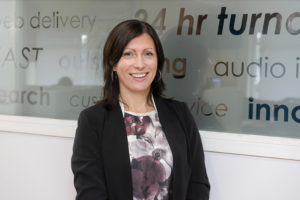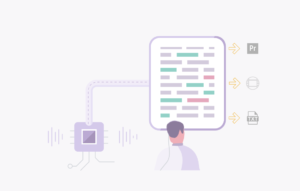M+E Connections

Take 1: Providing High-Quality Services at Scale
Story Highlights
For nearly 25 years, UK-headquartered Take 1 has offered video transcription services, along the way adding absolutely every localisation service a media and entertainment company could ask for.
Take 1 CEO Louise Tapia spoke with MESA about the changing technologies associated with the localisation business, the important rise of audio description services, and how Take 1 is keeping pace during today’s exponential — and global — growth in content offerings.
MESA: How did Take 1 first come on the scene, and what makes its localisation, transcription and access services stand out in the media and entertainment space?
 Tapia: In 1998, Take 1’s founder, Dom Bourne, dropped out of university and started a business providing video transcription services to production companies in the UK. The company operated from his childhood bedroom and Dom hoped it would keep him in beer money for a year or two before he decided what he really wanted to do with his life.
Tapia: In 1998, Take 1’s founder, Dom Bourne, dropped out of university and started a business providing video transcription services to production companies in the UK. The company operated from his childhood bedroom and Dom hoped it would keep him in beer money for a year or two before he decided what he really wanted to do with his life.
Today Take 1 provides transcription, access and localisation services to the international media and entertainment industry. With offices in the UK, US and Latin America, and a global workforce we leverage digital technology and data-driven workflows to provide high-quality, artisan services at scale.
Take 1 has the unique advantage of being involved from content production right through to global delivery, from creating original transcription data and translating rushes right through to producing subtitles, dubbing, captions and audio or video descriptions. And, because we produce a high-quality original master transcript as interchangeable data, we can use the transcription data to create more efficient workflows throughout the content supply chain (e.g. to provide dubbing artists with speaker labels and word counts per speaker and to provide subtitlers with character per line information).
MESA: For both transcription and captioning, Take 1 makes use of artificial intelligence technologies. How has this changed the business, what can be improved upon with AI, and are there any drawbacks that need to be improved on?
Tapia: On their own, AI tools aren’t yet able to produce the quality that our customers demand from Take 1, but artificial intelligence is an important part of our workflows. Rather than using ASR, online translation tools and similar products as catch-all problem solvers to replace the roles that people play in our processes, we use AI as a tool to provide people with more time to do high-value work. This can be as simple as using spell-check, capturing text on screen with optical character recognition tools or using time alignment to line up subtitle text with the corresponding audio. Our aim is to use AI to do the low skill, heavy lifting so that our team of linguists and media specialists have more time to spend on challenging and creative tasks.
MESA: Making content accessible to visually impaired audiences via audio descriptions is a growing corner of the business. What goes into this process, and how does Take 1 ensure the best content experience possible for everyone?
Tapia: Audio description makes content accessible for visually impaired audiences by providing an additional narration track that describes what is happening onscreen during natural pauses in the dialogue.
 Unlike subtitles or captions, audio descriptions are written and voiced to match the style and pace of the video, so we work with an extensive network of artists to provide a range of voices, accents and profiles to suit the content. For example, a children’s programme may be described with a fun tone and relatively fast pace while a horror movie’s descriptions will be more deliberate and will leave gaps for the all-important soundtrack to build tension.
Unlike subtitles or captions, audio descriptions are written and voiced to match the style and pace of the video, so we work with an extensive network of artists to provide a range of voices, accents and profiles to suit the content. For example, a children’s programme may be described with a fun tone and relatively fast pace while a horror movie’s descriptions will be more deliberate and will leave gaps for the all-important soundtrack to build tension.
AD scriptwriters also need to be skilled at writing descriptions of characters, actions and expressions that are accurate and neutral, but which elicit an appropriate emotional response – without telling viewers how to feel. We write scripts that are succinct enough to fit into the gaps between the original film’s dialogue, prioritising descriptions that are necessary for the audience to understand and enjoy the film.
Descriptions need to be accurate, but they also need to help immerse the audience in the story, which a list of facts wouldn’t achieve.
AD voices are normally recorded with specialised technology that automatically inserts countdowns and accommodates the dips and fades necessary for the description track. Many of our AD voice artists do their own recordings and are often experienced AD scriptwriters that can refine the script as necessary during recordings.
As you can see, producing audio descriptions is both an art and a science!
MESA: Similarly, closed captions were originally designed for deaf and hard of hearing audiences – how does Take 1’s process of producing these facilitate quality and scale?
Tapia: There’s never been more demand for captioned video content. Not only are organisations like OFCOM and the FCC consistently increasing the regulatory requirements for accessible programming, but the ability to watch video online and on-the-move has caused a spike in content consumption, changing viewing habits and driving new audiences to watch captioned videos.
The key to a good quality caption is to start with an accurate transcription which can then be converted into caption files tailored to the unique needs of different broadcasters, networks and platforms.
We believe in deriving data once and then using that data to create efficiencies across the content supply chain. Our proprietary metadata harvesting platform, Liberty, is integral to this data-driven approach — it supports the production of XML-based post-production scripts, TTML timed text for captioning, and the re-purposing of this data into the various documents, files and reports needed throughout the global content production workflow.
 MESA: With the increased demand for global content, more audiences are engaging with dubbed and subtitled programming — as we’ve seen with series like “Squid Games.” But this has also raised some interesting debates around quality and artistic license. What is Take 1’s position in this debate?
MESA: With the increased demand for global content, more audiences are engaging with dubbed and subtitled programming — as we’ve seen with series like “Squid Games.” But this has also raised some interesting debates around quality and artistic license. What is Take 1’s position in this debate?
Tapia: The job of the subtitler may seem simple but it’s highly complex. Not only are they responsible for negotiating the delicate balance between keeping translations as true to the original language dialogue as possible and incorporating cultural nuances, but they need to do this within a set character limit so that the subtitles fit on screen and are comfortable for viewers to read. There is no magic formula to get this right.
In the same way that certain details have to be sacrificed when adapting a book into a screenplay, we rely on expert linguists to choose the critical information when creating subtitles.
MESA: What are some of Take 1’s favourite use case stories to date, where media and entertainment companies made great use of your services?
Tapia: The work we did with B17 Entertainment to localise TikTok’s 2021 New Year celebration content is a good example of Take 1’s capabilities.
TikTok planned to ring in the New Year with the platform’s first long form original program — an unforgettable countdown loopback of the top TikTok moments of 2020 — played out on the official TikTok accounts across 80 countries. But the ambitious production plan left just one week for localisation, including Christmas Day.
And timing wasn’t the only challenge that this production presented – because the special was going to be shared across 80-plus territories including countries with strict censorship requirements, multiple versions of the show had to be created, transcribed, translated and subtitled.
 In addition, TikTok’s platform does not currently support embedded caption files — so each unique version had to be delivered with titles burnt into the original video master. This had significant implications for the localisation process. A normal captioning workflow would use low-res video references, and the final output would be delivered as a small SRT file, so we had to change our processes to enable the final delivery of multiple, large, high-resolution video files.
In addition, TikTok’s platform does not currently support embedded caption files — so each unique version had to be delivered with titles burnt into the original video master. This had significant implications for the localisation process. A normal captioning workflow would use low-res video references, and the final output would be delivered as a small SRT file, so we had to change our processes to enable the final delivery of multiple, large, high-resolution video files.
We relied on our global network of in-territory translators, working around the clock, across time zones to transcribe, translate and subtitle TikTok’s New Year’s Eve special, with the team also creating a customised subtitle template to ensure that the captions were ideally placed for vertical video viewing within the app.
Ultimately, Take 1 were responsible for localising 25 different versions of the show into 14 languages in under a week.
Read the full case study here.
MESA: What’s next for Take 1, what advances in your offerings do you see on the horizon?
Tapia: Now that we’ve expanded our services to cover the full content supply chain, we expect to spend the next few years deepening our relationships with existing clients by offering the full suite of services that support distribution and becoming a more dominant player in the sector.
Part of this will include working on partnerships and integration projects to make it easier for our customers to access and manage these services.









